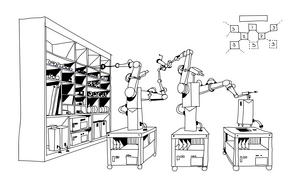
A self-replicating machine is a type of autonomous robot that is capable of reproducing itself autonomously using raw materials found in the environment, thus exhibiting self-replication in a way analogous to that found in nature.[1][2][3] The concept of self-replicating machines has been advanced and examined by Homer Jacobson, Edward F. Moore, Freeman Dyson, John von Neumann, Konrad Zuse[4][5] and in more recent times by K. Eric Drexler in his book on nanotechnology, Engines of Creation (coining the term clanking replicator for such machines) and by Robert Freitas and Ralph Merkle in their review Kinematic Self-Replicating Machines[6] which provided the first comprehensive analysis of the entire replicator design space. The future development of such technology is an integral part of several plans involving the mining of moons and asteroid belts for ore and other materials, the creation of lunar factories, and even the construction of solar power satellites in space. The von Neumann probe[7] is one theoretical example of such a machine. Von Neumann also worked on what he called the universal constructor, a self-replicating machine that would be able to evolve and which he formalized in a cellular automata environment. Notably, Von Neumann's Self-Reproducing Automata scheme posited that open-ended evolution requires inherited information to be copied and passed to offspring separately from the self-replicating machine, an insight that preceded the discovery of the structure of the DNA molecule by Watson and Crick and how it is separately translated and replicated in the cell.[8][9]
A self-replicating machine is an artificial self-replicating system that relies on conventional large-scale technology and automation. The concept, first proposed by Von Neumann no later than the 1940s, has attracted a range of different approaches involving various types of technology. Certain idiosyncratic terms are occasionally found in the literature. For example, the term clanking replicator was once used by Drexler[10] to distinguish macroscale replicating systems from the microscopic nanorobots or "assemblers" that nanotechnology may make possible, but the term is informal and is rarely used by others in popular or technical discussions. Replicators have also been called "von Neumann machines" after John von Neumann, who first rigorously studied the idea. However, the term "von Neumann machine" is less specific and also refers to a completely unrelated computer architecture that von Neumann proposed and so its use is discouraged where accuracy is important.[6] Von Neumann used the term universal constructor to describe such self-replicating machines.
Historians of machine tools, even before the numerical control era, sometimes figuratively said that machine tools were a unique class of machines because they have the ability to "reproduce themselves"[11] by copying all of their parts. Implicit in these discussions is that a human would direct the cutting processes (later planning and programming the machines), and would then assemble the parts. The same is true for RepRaps, which are another class of machines sometimes mentioned in reference to such non-autonomous "self-replication". Such discussions refer to collections of machine tools, and such collections have an ability to reproduce their own parts which is finite and low for one machine, and ascends to nearly 100% with collections of only about a dozen similarly made, but uniquely functioning machines, establishing what authors Frietas and Merkle refer to as matter or material closure. Energy closure is the next most difficult dimension to close, and control the most difficult, noting that there are no other dimensions to the problem. In contrast, machines that are truly autonomously self-replicating (like biological machines) are the main subject discussed here, and would have closure in each of the three dimensions.
- ^ Taylor, Tim; Dorin, Alan (2020), Taylor, Tim; Dorin, Alan (eds.), "Robot Evolution and the Fate of Humanity: Pop Culture and Futurology in the Early 20th Century", Rise of the Self-Replicators: Early Visions of Machines, AI and Robots That Can Reproduce and Evolve, Cham: Springer International Publishing, pp. 29–40, doi:10.1007/978-3-030-48234-3_4, ISBN 978-3-030-48234-3, retrieved 2024-04-06
- ^ Dodson, Sean (2008-07-02). "The machine that copies itself". The Guardian. ISSN 0261-3077. Retrieved 2024-04-06.
- ^ Granqvist, Nina; Laurila, Juha (2011). "Rage against Self-replicating Machines: Framing Science and Fiction in the US Nanotechnology Field". Organization Studies. 32 (2): 253–280. doi:10.1177/0170840610397476. ISSN 0170-8406. Retrieved 2024-04-06.
- ^ Cite error: The named reference
Böttiger_2011was invoked but never defined (see the help page). - ^ Cite error: The named reference
Eibisch_2016was invoked but never defined (see the help page). - ^ a b Freitas, Robert A.; Ralph C. Merkle (2004). Kinematic Self-Replicating Machines. Georgetown, Texas: Landes Bioscience. ISBN 978-1-57059-690-2.
- ^ "3.11 Freitas Interstellar Probe Replicator (1979-1980)". Molecularassembler.com. 2005-08-01. Retrieved 2009-09-16.
- ^ Rocha, Luis M. (1998), "Selected Self-Organization and the Semiotics of Evolutionary Systems", Evolutionary Systems, Springer, Dordrecht, pp. 341–358, doi:10.1007/978-94-017-1510-2_25, ISBN 978-90-481-5103-5
- ^ Brenner, Sydney (2012), "Life's code script", Nature, 482 (7386): 461, doi:10.1038/482461a, PMID 22358811, S2CID 205070101
- ^ Drexler, K. Eric (1986). "Engines of Abundance (Chapter 4) Clanking Replicators". Engines of Creation. Archived from the original on 2011-08-07. Retrieved 2007-02-19.
- ^ Colvin 1947, pp. 6–7.